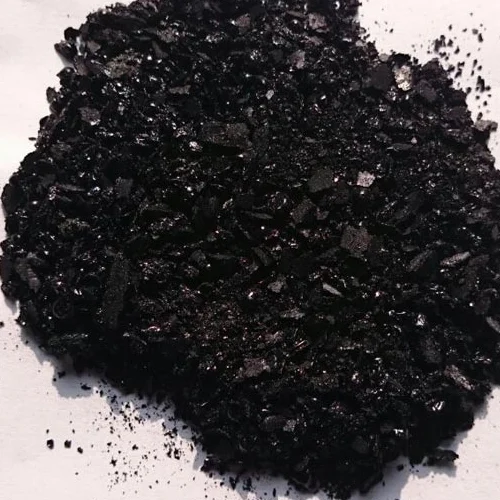Exploring the Versatile Applications and Benefits of Sulfur Black 1 in Various Industries
Understanding Sulfur Black 1 An Overview of its Properties and Uses
Sulfur Black 1, a versatile synthetic dye, is widely employed in various industries due to its unique properties and efficiency in dyeing processes. As a member of the sulfur dye family, it is known for its deep black color and exceptional lightfastness, making it a favored choice in textile applications, particularly for cotton and other cellulose fibers.
Chemical Composition
Chemically, Sulfur Black 1 is derived from a complex combination of sulfur and organic compounds, which contribute to its distinctive color and performance characteristics. The dye is formulated through a specific synthesis process that allows for the incorporation of sulfur atoms, providing the dye with its strong affinity for fiber. It is primarily available in a powdered form, which is then converted into a solubilized or dispersed state for application in dyeing.
Dyeing Process
The dyeing process using Sulfur Black 1 involves several key steps. Firstly, the textile material is treated with reducing agents that convert the insoluble dye into a soluble form, allowing it to penetrate the fibers effectively. Once the dye has been absorbed, oxidation is employed to convert it back to its original insoluble state, locking the color into the fibers. This unique two-step process is crucial, as it ensures that the dye adheres firmly to the fabric, resulting in colors that are long-lasting and resistant to washing and light exposure.
Applications
sulfur black 1 products

Sulfur Black 1 is predominantly used in the textile industry, particularly for dyeing cotton fabrics. Its excellent color yield and fastness properties make it ideal for producing dark shades, particularly in denim and heavy textiles. Additionally, it is used in the production of various clothing items, predominantly in outerwear and workwear, where durability and resistance to fading are essential.
Beyond textiles, Sulfur Black 1 finds applications in other industries as well. It is used in leather tanning processes, where it imparts rich, dark colors to leather goods. Moreover, the dye is employed in the manufacture of paper products, inks, and plastics, showcasing its versatility and adaptability across different materials.
Environmental Considerations
While Sulfur Black 1 is favored for its coloring properties, there are environmental concerns associated with its use. The dyeing process may involve hazardous chemicals and significant water consumption, leading to potential ecological impacts. To address these challenges, many manufacturers are now adopting more sustainable practices, such as implementing closed-loop systems that reduce water usage and recycling wastewater. Additionally, advancements in dye chemistry are being explored to create more environmentally friendly alternatives without compromising performance.
Conclusion
In summary, Sulfur Black 1 is a significant player in the world of dyes, offering a range of benefits across multiple industries. Its chemical composition lends itself to excellent dyeing properties, making it a popular choice particularly in textiles. While environmental concerns remain, continuous innovations and sustainable practices are on the rise, paving the way for a more responsible approach to dyeing processes. As consumer awareness of sustainability increases, the industry continues to adapt, ensuring that the use of dyes like Sulfur Black 1 can be both effective and environmentally conscious.
-
The Timeless Art of Denim Indigo Dye
NewsJul.01,2025
-
The Rise of Sulfur Dyed Denim
NewsJul.01,2025
-
The Rich Revival of the Best Indigo Dye
NewsJul.01,2025
-
The Enduring Strength of Sulphur Black
NewsJul.01,2025
-
The Ancient Art of Chinese Indigo Dye
NewsJul.01,2025
-
Industry Power of Indigo
NewsJul.01,2025
-
Black Sulfur is Leading the Next Wave
NewsJul.01,2025

Sulphur Black
1.Name: sulphur black; Sulfur Black; Sulphur Black 1;
2.Structure formula:
3.Molecule formula: C6H4N2O5
4.CAS No.: 1326-82-5
5.HS code: 32041911
6.Product specification:Appearance:black phosphorus flakes; black liquid

Bromo Indigo; Vat Bromo-Indigo; C.I.Vat Blue 5
1.Name: Bromo indigo; Vat bromo-indigo; C.I.Vat blue 5;
2.Structure formula:
3.Molecule formula: C16H6Br4N2O2
4.CAS No.: 2475-31-2
5.HS code: 3204151000 6.Major usage and instruction: Be mainly used to dye cotton fabrics.

Indigo Blue Vat Blue
1.Name: indigo blue,vat blue 1,
2.Structure formula:
3.Molecule formula: C16H10N2O2
4.. CAS No.: 482-89-3
5.Molecule weight: 262.62
6.HS code: 3204151000
7.Major usage and instruction: Be mainly used to dye cotton fabrics.

